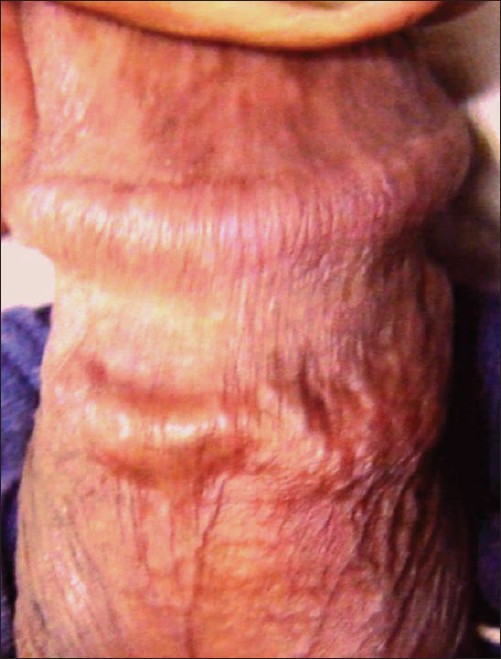Translate this page into:
An adult with a cord round the neck: Benign transient lymphangiectasis of the penis
Correspondence Address:
Ashok Ghorpade
1B, Street 13, Hospital Sector, Bhilai, Chattisgarh - 490 006
India
| How to cite this article: Ghorpade A. An adult with a cord round the neck: Benign transient lymphangiectasis of the penis. Indian J Dermatol Venereol Leprol 2007;73:353-354 |
 |
| Figure 1: Translucent, linear cord-like swelling near the coronal sulcus |
 |
| Figure 1: Translucent, linear cord-like swelling near the coronal sulcus |
Sir,
A 36-year-old married Indian male presented with a linear, cord-like lesion near the coronal sulcus of 2 days duration. The lesion had started about 30hours after the prolonged and vigorous sex twice with his wife. Although it was not painful, the site and cord-like appearance of the lesion had alarmed him and his wife. He had been married for the last 12 years and denied the occurrence of a similar episode earlier. There was no history of any systemic illness or use of any medicine or sexual stimulants. He and his spouse had no history of genital ulcers or urethral discharge.
Examination showed a healthy young man who had a skin colored, translucent, firm, nontender, approximately 2 mm wide, cord-like lesion above the coronal sulcus encircling it partly [Figure - 1]. The overlying skin was normal and freely mobile. The local temperature was not raised. There was no ulceration, urethral discharge, lymphadenopathy or other skin lesions. The routine hematological investigations, urine examination and blood test for VDRL and sickling were negative. The patient was explained about the self limiting nature of this benign condition, but he was quite anxious. Hence, he was started on tablet roxithromycin 150mg. twice daily for 7 days, which helped in the regression of the lesion within 2 weeks.
Sclerosing lymphangitis of the penis is an uncommonly reported condition, which usually manifests after hectic sexual intercourse or masturbation. [1],[2],[3] It is observed usually in the second or third decade, although it may occur between 18 and 66 years of age. [1] The condition is mostly asymptomatic; however, it can result in embarrassment due to its genital location, alarming appearance and its relation to hectic sex. Fortunately, it resolves spontaneously within 4-6 weeks without any complications.
The exact cause is still not very clear. While the lymphatic pathology has been blamed by some, others have reported findings suggesting a venous origin. [4],[5] According to Aragona et al. , [4] clinical, anatomical and histological findings indicate a primary involvement of the penile lymphatics, possibly after a prolonged period of sexual excitement. According to a more recent Indian report of this condition, the positive staining of vascular endothelial cells using CD31 and CD34 monoclonal antibodies suggested a venous pathology. Here, the authors did not find any evidence of lymphatic pathology. [4] The importance of trauma and an infectious agent as precipitating factors in the presence of an anatomical aberration in the venous arcade has been suggested in a recent report. [6]
Eighteen out of the 1296 STI cases were found to have this condition in a centre in North India. [4] According to Rosen and Hwong, [7] out of the 105 patients reported till 2003, approximately one-fourth had a close temporal relation to uncomplicated gonorrhea, nonspecific urethritis or a positive serologic test for syphilis. Two of their three patients had an underlying infectious disease and responded to oral/injectable antibiotics. In 1996, a similar response was reported from our department after using erythromycin tablets. [8] Most patients are quite disturbed and therefore reassurance regarding its benign nature is important. Abstinence and rest to the affected organ often helps. A recent report of Mondor′s disease occurring a day subsequent to a 15-h flight in a person is interesting. Earlier, after a long flight, the patient had a history of developing superficial thrombophlebitis in the varicose veins of his left lower limb. [9]
Sex, sexually transmitted diseases and masturbation were and are universally existent in abundance. Aphrodisiacs have been used since ancient times to increase desire and facilitate prolonged erection; there has been increase in recreational use of drugs such as sildenafil resulting in hectic sex and millions of men are enjoying the long duration flights. Against this backdrop, it is surprising that only a small number of cases (less than 135) of benign transient lymphangiectasis have been reported in literature. Is it that a larger number of people are moving around carrying such cords till they spontaneously disappear or is a more complex etiology responsible for this?
| 1. |
Greenberg RD, Perry TL. Nonvenereal sclerosing lymphangitis of the penis. Arch Dermatol 1972;105:728-9.
[Google Scholar]
|
| 2. |
Sieunarine K. Non-venereal sclerosing lymphangitis of the penis associated with masturbation. Br J Urol 1987;59:194-5.
[Google Scholar]
|
| 3. |
Boyd AS. Non-venereal sclerosing lymphangitis of the penis. Br J Dermatol 1970;82:632-3.
[Google Scholar]
|
| 4. |
Kumar B, Narang T, Radotra BD, Gupta S. Mondor's disease of penis: A forgotten disease. Sex Trans Infect 2005;81:480-2.
[Google Scholar]
|
| 5. |
Aragona P, Piazza R, Artibani W, Dante S. The so-called Hoffman's lymphangitis of the penis: Is it a lymphangitis or phlebitis? Int Urol Nephrol 1988;20:139-45.
[Google Scholar]
|
| 6. |
Rosen TR, Hwong H. Sclerosing lymphangitis of the penis. J Am Acad Dermatol 2003;49:916-8.
[Google Scholar]
|
| 7. |
Agrawal SK, Singal A, Pandhi D. Mondor's phlebitis of penis following recurrent candidal balanoposthitis. Int J Dermatol 2004;44:83-4.
[Google Scholar]
|
| 8. |
Ramanan C. Ghorpade A. Benign transient lymphangiectasis. Int J Dermatol 1996;35:575-6.
[Google Scholar]
|
| 9. |
Day S, Bingham JS. Mondor's disease of the penis following a long-haul flight. Int J STD AIDS 2005;16:510-1.
[Google Scholar]
|
Fulltext Views
7,032
PDF downloads
2,544





